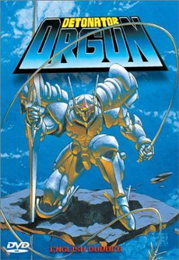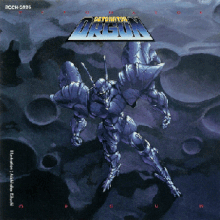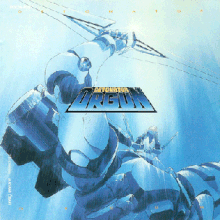Detonator Orgun
| Detonator Orgun | |
 Cover of American Detonator Orgun DVD. | |
| デトネイター・オーガン (Detoneitā Ōgan) | |
|---|---|
| Genre | Adventure, Mecha |
| Original video animation | |
| Directed by | Masami Ōbari |
| Produced by | Noburo Ishida Satoshi Koizumi Takanori Yaegaki |
| Written by | |
| Music by | Susumu Hirasawa |
| Studio | AIC, Artmic |
| Licensed by | |
| Released | 25 July 1991 – 25 March 1992 |
| Runtime | 55 minutes (each) |
| Episodes | 3 |
| Light novel | |
| Written by | Hideki Kakinuma |
| Published by | Kadokawa Shoten |
| Imprint | Kadokawa Sneaker Bunko |
| Demographic | Male |
| Original run | August 1991 – March 1992 |
| Volumes | 3 |
| Game | |
| Developer | Hot B |
| Publisher | Hot B |
| Genre | Adventure |
| Platform | Mega-CD |
| Released | 31 July 1992 |
Detonator Orgun (Japanese: デトネイター・オーガン, Hepburn: Detoneitā Ōgan) is a 1991 Japanese original video animation series by AIC and Artmic, directed by Masami Ōbari with character designs by Kia Asamiya (working under his real name, Michitaka Kikuchi).[not verified in body] Planning for the series started in 1989,[1] but the animation process did not start until 1991. The series was released on DVD in 2001 by Central Park Media in the United States, in 2002 by Happinet Pictures in Japan, and in 1997 by Manga Entertainment in the United Kingdom.[2] Orgun later appeared in the Super Robot Wars W video game.
Plot[]
Part 1 – Birth[]
Tomoru Shindo, a college student from City 5, is having dreams of a mecha named Orgun and protecting a woman from an hostile mecha. A meteor enters Earth's atmosphere and heads for City 5, revealing itself to be a hostile mecha from an alien race called the Evoluder. Earth Defense Force (EDF) Professor Michi Kanzaki receives signals from the Moon that are coming from a crash-landed mecha named Orgun, and rebuilds it in her laboratory. Orgun escapes and confronts the invading mecha, inviting Tomoru to merge with him. Together, the two defeat the mecha. Tomoru learns that Orgun is a defector from the invading Evoluder, who plan to destroy Earth with the battle planet Zoma's antimatter cannon. The blind oracle Kumi Jefferson predicts the planet's destruction.
Part 2 – Pursuit[]
The EDF create robotic suits based on Orgun in order to defend Earth. Orgun and Tomoru meet two of the Evoluder: Leave, who dies protecting Orgun, and Rang, who battles Orgun in anger for his treason. It is revealed that the Evoluder are the descendants of a manned space mission Earth sent to the Cygnus constellation 200 years earlier, whose crew evolved into mechanical lifeforms due to experiencing millions of years of time dilation during the journey. Some of the Evoluder are telepathically linked to certain humans, such as Tomoru with Orgun and Kumi with the Evoluder's leader, Mhiku.
Part 3 – Showdown[]
Using their robotic suits, the EDF repels the Evoluder's invasion force. Kumi uses her telekinetic powers to move the Sun so Orgun can save the Earth. Zoa, the Evoluder's military commander, fires the antimatter cannon. Orgun uses his Grand Cross attack to kill Zoa and destroy the cannon. Orgun crashes onto a beach and dies while Tomoru survives. Mhiku resumes ruling the Evoluder, who peacefully leave Earth. Tomoru and Kanzaki walk off into the sunset while Orgun's remains are displayed in a museum.
Characters[]
- Tomoru Shindo / Orgun (オーガン)
- Voiced by: Kōichi Yamadera / Ted Lewis (US) / Roger May (UK)
- Yohko Mitsurugi
- Voiced by: Emi Shinohara / Katherine Devaney (US) / Sara Williams (UK)
- I-Zack
- Voiced by: Nobuo Tanaka / Justin Thompson (US)
- Professor Michi Kanzaki
- Voiced by: Yumi Tōma / Angela Parks (US) / Joanna MacInnes (UK)
- Bannings
- Voiced by: Bōya Ueda / Robert Chase (UK)
- Kumi Jefferson / Miku
- Voiced by: Hiroko Kasahara / Jessica Calvello (US) / Sarah Wateridge (Kumi) Elizabeth Pearce (Mhiku) (UK)
- Commander Zoa
- Voiced by: Kenji Utsumi / Matthew Bray (US) / William Roberts (UK)
- Virgil
- Voiced by: Masashi Ebara
- Lang
- Voiced by: Norio Wakamoto / Vinnie Penna (US)
- Simmons
- Voiced by: Norio Wakamoto
- Foreston (フォレストン)
- Voiced by: Takkō Ishimori / Jeffrey Gimble (US) / Stephen Lyons (UK)
- Nokku
- Voiced by: Toshihiko Seki / Corey Carthew (US) / Daniel Marinker (UK)
Music[]
hideThis section has multiple issues. Please help or discuss these issues on the talk page. (Learn how and when to remove these template messages)
|
| Detonator Orgun ORIGINAL VIDEO ANIME SOUNDTRACK | ||||
|---|---|---|---|---|
 | ||||
| Soundtrack album by Susumu Hirasawa | ||||
| Released | 25 July 1991 (1) 25 October 1991 (2) 25 March 1992 (3) | |||
| Genre |
| |||
| Label | Polydor K.K. | |||
| Producer |
| |||
| Susumu Hirasawa soundtrack chronology | ||||
| ||||
| Singles from Detonator Orgun 1 | ||||
| ||||
| Following episodes | ||||
 Detonator Orgun 2 | ||||
| Alternative cover | ||||
 Detonator Orgun 3 | ||||
Polydor K.K., a member of the series' production committee, recommended Susumu Hirasawa, an artist from their roster, to compose music for the series.[3] Hirasawa took the role because of a wish to work with producer Satoshi Koizumi, whose personality drew Hirasawa in after requesting him to dispel the image that anime soundtracks had.[4] The composer was asked to write the anime's main theme first, and it was presented to Koizumi and director Masami Ōbari in late 1990, before animation had started.[5][6]
Hirasawa wrote and performed all the music for the OVA, in his film score composer debut (previous soundtrack work amounted to commercial jingles and pro wrestling entrance themes). Similarly to his solo albums Water in Time and Space, The Ghost in Science and Virtual Rabbit, Hirasawa mixed together electronic and symphonic sounds, using elements across a broad range of music styles, with a large focus on classical music. At the time, Hirasawa thought of anime and movie soundtracks only as enhancements and not as standalone works, and made the soundtracks considering it as "a job" and "entertainment", employing an epic tone and dramatic exaggeration in his composing.[7] He drew songwriting elements from his solo albums throughout the soundtrack, and used already-made songs from them as ending themes and insert songs. The first soundtrack was made simultaneously with Virtual Rabbit, and was made by Hirasawa basing himself on production materials.[8] Detonator Orgun 3 was entirely recorded on Hirasawa's private Studio Wireself.[9]
Hirasawa eventually got tired of working on the series, and considered Detonator Orgun 3 to be the worst album of his solo career, yet also considers the experience helpful in making later soundtracks, in particular the music for the Berserk series,[10] and regards the "grand and delicate" technique for orchestral tones he developed through this soundtrack as guidance for his later works in general.[4][7] Series writer enjoyed the soundtrack, later commissioning Hirasawa to compose for his fantasy manga Glory Wars; this music was later released as an image mini-album of the same name.[10]
To promote the album, the remix of "Bandeira Travellers" (used as the ending theme of episode 1) was released a month ahead as a single and a sampler Mini CD, while the opening and ending themes of episode 1 were distributed to interested parties.[citation needed] In addition to the episode soundtracks, a drama CD was also released, containing select music from the soundtracks and audio from the series itself.[citation needed]
The series' main theme was included on the 2007 compilation Music For Movies: World of Susumu Hirasawa Soundtracks. Hirasawa had the soundtracks remastered for the 2012 boxset ; his former record label did the same for the 2014 compilation Symphonic Code (since those were catalog-wide projects, songs that were also present on other albums were omitted to avoid duplication, being either included on earlier discs of the boxset or on the Archetype compilation). Glory Wars was bundled together with the soundtracks for these reissues.
Hirasawa has seldom brought up his soundtracks for the series in his overall career.[citation needed] Some P-Model material originated out of the soundtrack. In his 1994 shows, the title theme was played over the PA system before they began; Hirasawa usually opened his shows with "Frozen Beach '94", a rearrangement of "YOHKO Mitsurugi" with the lyrics of "Frozen Beach". A studio recording of this version, simply titled "FROZEN BEACH", was released a year later on the Scuba Recycle album.[citation needed]
All tracks are written by Susumu Hirasawa. "Bandeira Travellers" and "SUNSET" have string and choral arrangements by Hirasawa and Kayo "Kokubo" Matsumoto. "Root of Spirit" titled by Toshiaki Minejima with string arrangement by Jun Miyake.
| No. | Title | Length |
|---|---|---|
| 1. | "DETONATOR ORGUN" | 4:12 |
| 2. | "KUMI Jefferson" | 3:38 |
| 3. | "E.D.F." | 3:04 |
| 4. | "YOHKO Mitsurugi" | 2:45 |
| 5. | "EVOLUDERS" | 3:08 |
| 6. | "City-No.5" | 3:06 |
| 7. | "MICHI Kanzaki" | 2:12 |
| 8. | "P.A.S.F.U." | 1:47 |
| 9. | "PROPAGANDA of E.D.F." | 1:39 |
| 10. | "MUSEUM" | 2:36 |
| 11. | "FÜHRER MEEK" | 3:40 |
| 12. | "Bandeira Travellers (Physical Navigation Version)" (バンディリア旅行団 Bandiria Ryōkōdan) | 5:01 |
| No. | Title | Length |
|---|---|---|
| 1. | "SUNRISE" | 1:11 |
| 2. | "Clear Mountain Top" (山頂晴れて Sanchō Harete) | 4:08 |
| 3. | "DETONATOR ORGUN" | 4:12 |
| 4. | "LEAVE" | 2:43 |
| 5. | "NIGHTMARE" | 4:44 |
| 6. | "TERROR" | 1:05 |
| 7. | "YOHKO & TOMORU" | 1:16 |
| 8. | "ORGUN & TOMORU" | 0:59 |
| 9. | "Venus" (金星 Kinsei) | 3:16 |
| 10. | "LUNGE" | 4:33 |
| 11. | "SUNSET" | 4:54 |
| No. | Title | Length |
|---|---|---|
| 1. | "DETONATOR ORGUN" | 4:12 |
| 2. | "PROPAGANDA of E.D.F. II" | 0:32 |
| 3. | "DREAM QUEST" | 3:30 |
| 4. | "DUAL MIND" | 1:03 |
| 5. | "TOMORU & MICHI" | 1:12 |
| 6. | "Water in Time and Space (Full Size)" (時空の水 Jikū no Mizu) | 4:01 |
| 7. | "ZORMA" | 0:42 |
| 8. | "SPACE FORCE" | 1:11 |
| 9. | "CLIMAX" | 5:05 |
| 10. | "HOPE" | 0:32 |
| 11. | "" (魂のふる里 Tamashii no Furusato) | 5:43 |
Personnel[]
- Susumu Hirasawa – Synthesizers, Drum machine, Sampler, Sequencers, Amiga 2500, Programming, Vocals, Electric guitar, Classical guitar, Production
- – Backing Vocals on "Bandeira Travellers"
- Teru Uchida Strings – Strings on "Bandeira Travellers" and "SUNSET"
- Jun Togawa – Vocals on "Clear Mountain Top"
- , Osamu Takeuchi and Chūju Yamaguchi – Backing Vocals on "Clear Mountain Top"
- Shingo Tomoda – Drums on "Venus"
- Kayo "Kokubo" Matsumoto – Acoustic Piano on "Water in Time and Space (Full Size)"
- Section – Violins, Cellos, Violas and Contrabasses on "Root of Spirit"
- Yoshiaki Kondo – Engineering on "Venus" and "Root of Spirit"
- Masanori Chinzei – Engineering, Backing Vocals on "Clear Mountain Top"
- Yūichi Kenjo – Executive Production, Backing Vocals on "Clear Mountain Top"
- Michitaka Kikuchi – Illustrations (1 & 2)
- Masami Ōbari – Illustrations (3)
Reception[]
Detonator Orgun has received mostly mixed reception. Ben Carlton of Manga Mania praised the series' art: "Tomoru lives in a future world which is bright, clean, and scarily antiseptic. The military look like plastic toys in their chunky armour and craft. [...] skies are as rich and beautiful as any in Macross Plus". He also noted that: "Tomoru's world is also sharp and crisp as only anime can make it, with every edge and colour defined, giving more tension to the robot battles and dream sequences, where with every major change or impact the image loses definition in a sudden blur of brightness or shadow." On the other hand, Carlton criticized the UK dub's mixing, describing it as "sadly, disappointing, with uneven levels and what sounds like some nice music almost drowned out."[11]
Helen McCarthy in 500 Essential Anime Movies called the anime an "intriguingly fresh take on the traditions of giant robot shows", noting that three "hour-long episodes allow plenty of time to develop concepts and characters".[12]
Paul Thomas Chapman, writing retrospectively for Otaku USA, criticized the series, stating that "it starts off dull, proceeds to take an interesting twist and mangle it beyond recognition, and concludes in a manner that can only be described as complete and utter nonsense, even by anime standards". When he talks about a scene where Kumi moves the sun with telekinetic powers, Chapman states "I don't have enough exclamations points to describe how ridiculous that is." Comparing the series to other works by its staff, he notes that "it's no surprise that the themes explored in Detonator Orgun—trans-humanism, the loneliness of space, the cyclical nature of history, and the sense of futility experienced by cultures consumed by war—are so similar to those explored in Gall Force [...] But whereas Gall Force felt like a sincere work of popular science-fiction, Orgun feels like [Hideki] Kakinuma repeating himself, chewing over an idea he's already examined more thoroughly and with greater skill. As for future utopias and transformation as a metaphor for self-actualization, I've seen this kind of imagery from Masami Obari before and since," comparing the series to Angel Blade.[13]
References[]
Some of this section's listed sources may not be reliable. (December 2015) |
- ^ "吉祥寺怪人 on Twitter: "【オーガンと音楽:1】 OVAとして'89年から企画され、最初は玩具メーカーで発売予定だったが色々あって音楽メーカーP社に決定。色々なかったら平沢さんとの出会いもなかったことになる。 いや、出会いとかを越え、オーガンの音楽はすでにそこにあった…そんな感覚が正しいかも。"". Twitter. 16 June 2012. Retrieved 14 October 2015.
- ^ "Detonator Orgun". British Board of Film Classification. 4 July 1997. Retrieved 18 June 2018.
- ^ "吉祥寺怪人 on Twitter: "【オーガンと音楽:2】 '90年、P社から音楽は平沢さんはどうかと推薦され、さっそく本社で会議。作品の世界観をひととおりご説明すると「なにもそこまで!?…という感じでよいのですね」という平沢さんの発言で会議は無事終了した。"". Twitter. 16 June 2012. Retrieved 14 October 2015.
- ^ Jump up to: a b Hirasawa, Susumu. "introduction/self-interview text version 平沢ソロのできるまで – introduction No. 2 エンジニアリング". The Aggregated Past KANGENSHUGI 8760 HOURS (in Japanese). Chaos Union. Retrieved 25 February 2016.
- ^ "吉祥寺怪人 on Twitter: "【オーガンと音楽:3】 まずテーマ曲を先行して作曲していただくことになった。 '90年の年末近く、山中湖のスタジオで『DETONATOR ORGUN』を聴かせていただいた。 「平沢さん…なにもそこまで…!」と思わず言ってしまいそうになるほどの躍動に震えた。"". Twitter. 16 June 2012. Retrieved 14 October 2015.
- ^ "吉祥寺怪人 on Twitter: "【オーガンと音楽:4】 興奮のまま帰社した私は大張監督に電話をかけ、テープを再生しスピーカーに受話器を押し当て試聴してもらった。 電話の向こうで監督は本作の勝利を確信したという。 まだ1カットも動く画面のない状況下、平沢さんの曲の中には、既にオーガンが躍動していたからである。"". Twitter. 16 June 2012. Retrieved 14 October 2015.
- ^ Jump up to: a b Nakano, Yasuhiro (29 February 2012). "Disc 08-16". (PDF file included on Data Disc) (in Japanese). Chaos Union, TESLAKITE. p. 2. CHTE-0061.
- ^ ""何をそこまで"がキーワード。やるだけやったヒューマンなテクノ音楽" ["What is 'Too Much'?” is the Keyword. I Only Made Human Techno Music]. NEWS & NEWTYPE – Music. Newtype – THE MOVING PICTURES MAGAZINE (in Japanese). Vol. 7 no. 9. Kadokawa Shoten. 10 August 1991. p. 165.
- ^ "P-Model Recording Report". Sound & Recording Magazine (in Japanese). No. 3. Rittor Music. March 1992. p. 53. ISSN 1344-6398.
- ^ Jump up to: a b "RocketBaby's interview w/Susumu Hirasawa". RocketBaby. Neo Cosmic Industries. Archived from the original on 3 March 2001. Retrieved 3 March 2001.
- ^ Carlton, Ben (1997). "Postmortem". Manga Mania. No. 42. London: Titan Magazines. p. 83. ISSN 0968-9575.
- ^ McCarthy, Helen (2008). 500 Essential Anime Movies: The Ultimate Guide. New York: Collins Design. p. 55. ISBN 9780061474507.
- ^ Chapman, Paul Thomas (24 March 2014). "The Vault of Error: Detonator Orgun". Otaku USA. Sovereign Media. Retrieved 28 October 2016.
External links[]
- Detonator Orgun (anime) at Anime News Network's encyclopedia
- Detonator Orgun at IMDb
- AnimeOnDVD review
- 1991 anime OVAs
- 1991 Japanese novels
- 1991 manga
- Adventure anime and manga
- Anime International Company
- Anime with original screenplays
- Central Park Media
- Kia Asamiya
- Light novels
- Mecha anime and manga